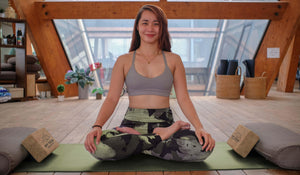3 Ways to Incorporate Yoga Blocks Into Your Practice
There’s a misconception that using yoga props somehow equates to inexperience or weakness – this couldn’t be farther from the truth. Whether you’re new to practicing yoga or have been practicing for years, props offer many benefits. Yoga blocks, in particular, are a diverse tool that can be used for a variety of reasons at all levels.
1. Alter Your Reach
One of the most common reasons practitioners use yoga blocks is simple: to alter the depth of your reach. This doesn’t always have to do with being new to the practice or having tight hamstrings – anatomical differences like arm, leg, or torso length can also impact the length of an individual’s reach. Blocks allow you to both modify and deepen a pose:

- Blocks can act as an extension of your arms. When in a wide-legged forward fold, for instance, reaching the ground with your hands is not necessarily accessible for everyone. Placing blocks beneath your hands simply brings the ground closer to you.
- Blocks also allow you to deepen your reach. Whether as a result of natural arm length or hamstring flexibility, some practitioners can reach past their toes in a seated forward fold, for example. Placing a block against the soles of your feet allows you to reach around to grab hold of the block instead, allowing you to find even more depth in that stretch.
2. Encourage Safe Alignment
If you’ve ever practiced side angle pose and were cued to reach for the ground with your bottom hand, you’ve likely had a moment of “how?” For some practitioners, the instinct is to follow the cue and reaching for the actual ground – which ultimately leads to shortening your waist on one side in a pose that’s intended for lengthening. Placing a block under your hand helps you lift away from the floor while still grounding your hand on an object – allowing you to find safe alignment in the pose instead of forcing yourself toward the floor and risking potential injury.

Side angle is just one example of a pose where blocks promote safe alignment over pushing your body past its edge to some perceived goal. Incorporating blocks doesn’t prevent you from deepening your practice – it facilitates a gradual expansion of your comfort and safety zones.
3. Practice Poses That Require Blocks
There are certain poses, particularly in restorative practices, that actually call for blocks and cannot be practiced without them. Restorative yoga’s aim is to help the body achieve release, whether in the muscle fibers or even deeper into the tendons and connective tissues, by holding poses in a way that is supported and allows the mind and body to relax.

One example of a restorative pose is supported bridge, where the intention is to provide support for your lower back using a block in order to create opening across the front line of the body that can be held for an extended period of time without straining the back. Without a yoga block, this pose isn’t possible.


